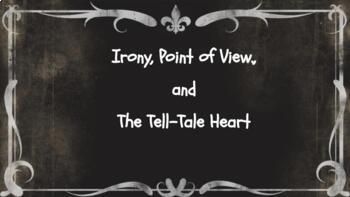Irony, Point of View, and "The Tell-Tale Heart" by Edgar Allan Poe
- Google Slides™

What educators are saying
Description
This is a Google slides presentation that can be used as a whole group, individual, or small group assignment.
It covers the standards LAFS.8.RL.2.6 and LAFS.8.RL.3.7. It goes over the three forms of irony, what Point of View is, and then asks text dependent questions throughout a chunked version of the short story "The Tell-Tale Heart" by Edgar Allan Poe. It includes an animated version of the story created by Annette Jung and then asks the students to compare and contrast the story and the film and answer academic discussion questions at the end.
This also includes a link to a dramatic reading of the story (to use for audio) by G.M. Danielson on the last slide. It is a great audio resource to utilize while reading the story.
**PLEASE NOTE: THE PREVIEW DOES NOT INCLUDE ALL SLIDES!**


